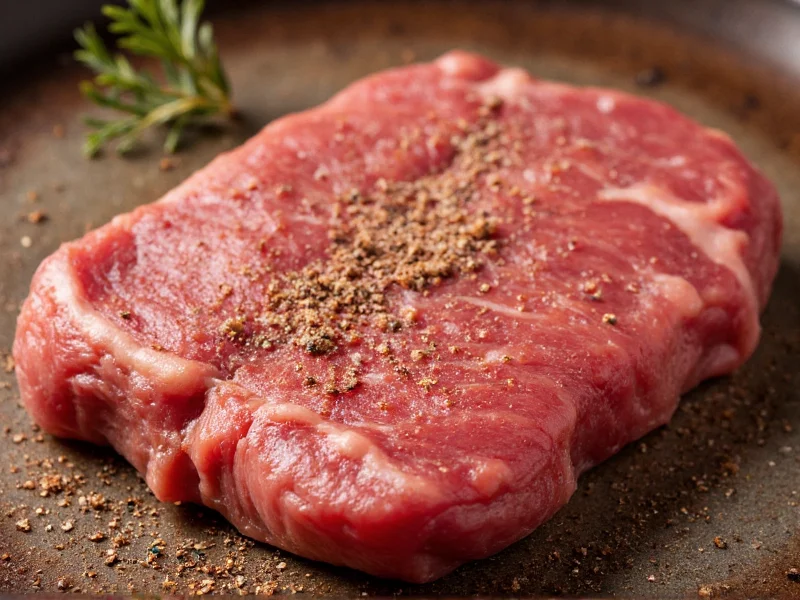Creating exceptional steak doesn't require complicated spice blends. The most effective steak seasonings often contain just a few high-quality ingredients that complement rather than mask beef's natural richness. This guide reveals why simplicity wins when seasoning steak and provides precise measurements for consistent results every time.
Why Minimalist Seasoning Works Best for Steak
Professional chefs consistently return to basic seasoning combinations because they understand that quality beef needs enhancement, not disguise. Overly complex blends with sugar, paprika, or multiple exotic spices can burn during high-heat cooking and create bitter flavors. The ideal simple steak seasoning for beginners focuses on three fundamental elements that perform specific functions:
- Salt - Breaks down muscle fibers for tenderness and enhances natural umami
- Pepper - Adds aromatic complexity and subtle heat
- Garlic powder - Provides savory depth without burning like fresh garlic
Perfect Proportions for Basic Steak Seasoning
Maintaining the correct ratio ensures balanced flavor that complements rather than dominates. This easy steak seasoning recipe works for all cooking methods from cast-iron searing to grill preparation:
| Ingredient | Measurement | Function |
|---|---|---|
| Kosher salt | 2 parts | Flavor enhancement and tenderizing |
| Freshly ground black pepper | 1 part | Aromatic complexity |
| Garlic powder | 1 part | Savory depth without burning |
For practical application, use 1 teaspoon of this blend per pound of steak. The coarse texture of kosher salt provides better adhesion and controlled salting compared to fine table salt. Always grind pepper fresh for maximum aromatic compounds - pre-ground pepper loses 70% of its volatile oils within 30 minutes.
Advanced Application Techniques
How you apply your basic steak seasoning proportions significantly impacts results. Follow these professional techniques:
Timing Matters Most
Apply seasoning at least 45 minutes before cooking, ideally 1-2 hours for thicker cuts. This allows salt to penetrate beyond the surface, seasoning the interior while drawing out moisture that then reabsorbs for better crust formation. Contrary to popular belief, salting well in advance doesn't make steak watery - it creates superior texture.
Pressure Application Method
Press the seasoning firmly into the meat's surface with your fingertips. This creates better adhesion than simply sprinkling and prevents seasoning from falling off during cooking. Focus on creating an even, visible layer that covers all surfaces without piling.
Variations for Different Preferences
While the three-ingredient foundation works universally, these subtle modifications accommodate different tastes while maintaining simplicity:
- For smoky depth: Add 1/4 part smoked paprika (use sparingly as it burns easily)
- For umami boost: Include 1/8 part onion powder
- For special occasions: Finish with flaky sea salt after cooking
- For leaner cuts (like filet): Increase salt ratio to 3:1:1 for better tenderizing
Avoid adding sugar to your minimalist steak seasoning blend unless specifically grilling at lower temperatures. Sugar caramelizes quickly and can create bitter compounds when searing at high heat.
Storage and Freshness Tips
For optimal flavor, prepare your homemade steak seasoning with few ingredients in small batches. Store in an airtight container away from light and heat. Properly stored:
- Salt maintains quality indefinitely
- Freshly ground pepper retains 80% of flavor for 2 weeks
- Garlic powder stays potent for 3-4 months
Never store seasoning blends in refrigerator humidity. The moisture causes clumping and flavor degradation. For best results, make enough for 2-3 uses at a time.
Common Mistakes to Avoid
Even with a best simple steak rub, these errors undermine results:
- Seasoning cold steak - Bring meat to near room temperature first for even seasoning absorption
- Using table salt - Its fine crystals over-salt and don't adhere well
- Adding liquid ingredients - Creates steam instead of sear (save marinades for other applications)
- Seasoning immediately before cooking - Doesn't allow time for flavor development
Remember that steak quality matters more than seasoning complexity. A well-marbled cut properly seasoned simply will always outperform prime beef drowned in complicated rubs.
Frequently Asked Questions
Can I use this simple steak seasoning on other meats?
Yes, this basic blend works well with most proteins. Reduce salt by 25% for chicken or pork, and omit garlic powder for seafood applications. The salt-pepper foundation remains universally effective across meat types when adjusted for density and cooking time.
How much seasoning should I use for a thick-cut steak?
For steaks over 1.5 inches thick, use 1.5 teaspoons of seasoning per pound. Thicker cuts require slightly more seasoning to properly penetrate the increased surface area. Apply seasoning to all sides including edges for complete coverage.
Why does my simple seasoning burn when searing?
Burning typically occurs when using fresh garlic or onion instead of dried powders, or when adding sugar to the blend. The three-ingredient foundation (salt, pepper, garlic powder) shouldn't burn if your cooking surface is properly preheated but not smoking. Ensure your pan or grill is at 400-450°F, not higher.
Can I make this seasoning without garlic powder?
Absolutely. The essential foundation is salt and pepper in a 2:1 ratio. Garlic powder adds complexity but isn't mandatory. For a truly minimalist approach, use just kosher salt and freshly cracked pepper. Many traditional steakhouse preparations use only these two ingredients.











 浙公网安备
33010002000092号
浙公网安备
33010002000092号 浙B2-20120091-4
浙B2-20120091-4